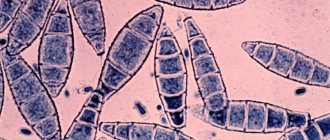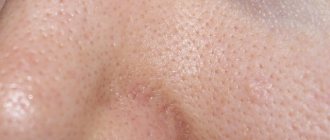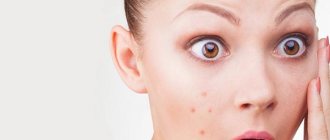Ringworm in children: features of the disease
Ringworm occurs in almost 90% of children, affecting the skin of both infants and older children. Occurs in adolescence. There are many types of disease, and accurate differentiation allows for the most appropriate therapy. The help of a doctor (pediatrician, mycologist, dermatologist) in this case is irreplaceable: firstly, the doctor will make the correct diagnosis by conducting the necessary tests (lichen rashes are similar to many other skin lesions), secondly, he will prescribe appropriate treatment taking into account all indications, severity and age of the child. Each type of lichen requires a different approach and duration of use of certain means. Therefore, before treating lichen in a child, the correct diagnosis should be made. It is almost impossible to do this on your own.
The symptoms of all types of disease are similar. Ringworm in children manifests itself as scaly spots, barely noticeable at first, then more pronounced. Their color ranges from light pink to bright red, and may turn brown over time. The spots are itchy, the scales look like whitish flakes. Children, especially younger ones, may have a fever; lymph nodes enlarge. Spots appear on the neck, chest, back, shoulders, stomach and thighs; some types of fungi “live” on the head and nails.
When and how can a child become infected?
Microsporia is a highly contagious (highly contagious) disease caused by dermatophyte fungi (literally, growing on the skin) of the genus Microsporum.
There are several types of this fungus that cause the development of three forms of the disease.
Anthropophilic and zoophilic forms of microsporia are widespread in Russia.
The disease occurs throughout the year. However, zoophilia is characterized by seasonality: the largest number of cases are recorded in late summer and autumn.
Trichophytosis, or ringworm in children
Ringworm (trichophytosis) affects the skin, nails and hair. There are 3 types of trichophytosis:
- Superficial
- Chronic
- Infiltrative-suppurative
The incubation period for each species is different. In the superficial form (the most common) it lasts 5-7 days, infiltrative-suppurative – up to 2 months. The chronic form appears due to untreated superficial. A child becomes infected from another child or adult through objects (comb, toys, books, towels, clothes), in the pool, as well as from a sick animal (through wool). Ringworm in children is much more common than in adults, affecting either the scalp or smooth skin. Small or large spots with white scales appear on the head. The hair becomes dull and breaks off, leaving stumps. This is where the name “cutting” comes from. Nails rarely suffer; if this happens, the nail plates peel, crumble, peel off, and become gray. Individual nodules on smooth skin merge into large itchy spots. There is no inflammation (except in cases of infection at the site of the lesion, which happens with small children who find it difficult not to itch).
Timely treatment of ringworm in children leads to complete recovery. In cases with severely affected scalp, scarring may remain after therapy. Advanced trichophytosis can also lead to baldness. To prevent this from happening, you should visit a dermatologist if your child experiences the following symptoms:
- bright on the head, body skin, round in shape, pink-red in color, with more or less clear edges;
- profuse dandruff (spots can flake quite strongly and strongly resemble dandruff, gradually turning into a chronic form);
- hair loses its shine and breaks off in places;
- The skin itches, and the child, not busy with activities, constantly scratches his head or body.
Who is at risk?
Children of preschool and school age most often
Whereas in adults the disease is rare. This is due to the fact that after puberty, the sebaceous glands of the skin produce more fatty acids, which have a detrimental effect on the fungus.
In addition, the disease is more common in patients with predisposing factors :
• Immune system dysfunction
• Endocrine diseases: diabetes mellitus, decreased thyroid function
• Lack of vitamins
• Poor housing, communal and living conditions
• High humidity and hot weather
• Presence of abrasions, cracks or scratches on the skin
• Tendency to excessive sweating
This is due to the fact that in these conditions, local immunity on the skin decreases, which facilitates the penetration of the fungus.
On a note
In children with skin allergic manifestations, microsporia can “masquerade” as the underlying disease - for example, with atopic dermatitis. What's happening? The fungus invades the site of existing rashes, significantly complicating diagnosis and treatment.
In addition, local use of hormonal ointments reduces the protective ability of the skin, which facilitates easy penetration and spread of the fungus.
Treatment of lichen in children and prevention of relapses
Treatment of lichen in children should be carried out exclusively under the supervision of a dermatologist. Experienced specialists at your Clinic today treat this disease with a 10% discount if you submit an application online.
The choice of treatment regimen depends on the type of lichen and the severity of the manifestations. The approach to treatment is complex; the choice of ointment is based on test data and individual tolerance to the drug. The doctor selects medications in such a way as to eliminate all signs of the disease as quickly as possible, while making sure that the lichen does not return again. Therapy methods:
- Antifungal (mycotic) drugs for external use. These are various ointments, lotions, solutions, aerosols, sprays, creams for application to affected areas. Depending on whether the lichen is found on the skin or hair, the form of the medicine is prescribed so that it is convenient to use. The mechanism of action is antifungal, inhibits the growth of fungi. Ointments include a certain percentage of the active substance, for example, miconazole, terbinafine, clotrimazole, ketoconazole, etc. There are dozens of types of drugs, and the doctor will help you choose the optimal substance, form and dose.
- Oral medications allow you to quickly get rid of the symptoms of the disease, improve sleep, and eliminate peeling and itching.
- Anti-inflammatory and antibacterial agents - in case of inflammation or infection in the scratched wound.
- Vitamins of group B, C.
Today it’s easy to get rid of lichen; the main thing is to make the correct diagnosis and follow all the specialist’s recommendations. Your doctor will tell you how to treat lichen in a child most effectively. He is the one who will select a comprehensive therapy that is suitable for your child. The peculiarity of treating children is to select the correct dosage - it is difficult to do this on your own, especially if the disease appears in an infant. The spots can be very itchy, so children may develop sore spots on their scalps. At night it is difficult to fight this, but during the day you need to try to distract the child with drawing, modeling and other interesting activities, use ointments and sprays that relieve itching. Lotions of solutions of iodine, silver nitrate, and ichthyol will help reduce the manifestations of inflammation, especially in the suppurative form. Treatment of lichen in children occurs mainly at home, but if there is a high temperature and the child’s condition is quite serious, in the hospital. Therapy takes 1-2 weeks, with an infiltrative-suppurative form – slightly longer.
Who is at risk for infection?
Sick children and adults, carriers of fungal spores, or affected animals with which children come into close contact can be contagious to children. Most often, lichen is transmitted from street cats and dogs, especially small ones. In them, this infection occurs more easily than in humans; the areas of affected skin may be small and barely noticeable under the skin.
Children often get sick, becoming infected from each other, through close contact or sharing clothing, bed linen, and hygiene items (towels, washcloths, nail files, combs). There is a higher risk of contracting fungal spores in the presence of injuries, cuts, scratches and scratches on the skin, sunburn and dermatitis. When the immune system is weakened, under the age of 3, children get sick more often and more severely.
How does a fungal infection occur?
It is possible to contract such an infection in several ways, including transmission from a person with confirmed mycosis, from animals, and extremely rarely from soil. The most common locations where you can become infected with fungus are places with high humidity, baths, saunas, and swimming pools. Particularly favorable environments for the life of fungus are wooden coverings, places of stagnation and accumulation of water.
The infection itself occurs due to pathogenic scales from the affected skin, which remain on the floor when people with a mycotic infection walk with their bare feet.
It is important to consider that you can become infected with a fungal infection in public places where fungal spores can get on the hands, face and other parts of the body of a healthy person, for example in a pedicure salon, on the beach, in hotels. Also, parents suffering from a mycotic infection can infect their own child through close contact and failure to comply with personal hygiene rules.
⠀
In children, a fungal infection develops quite quickly due to increased vascularization of children's skin, reduced bactericidal activity of the sweat and sebaceous glands, as well as due to the immaturity of the immune system. All this affects the reproduction and penetration of the fungus into the child’s epidermis.
Mechanism of fungal infection
You can become infected if particles of dandruff, epidermis, hair or animal fur contaminated with the fungus come into contact with your skin. Fungal spores in the ground remain active for up to three months during the warm season. Getting from the ground onto the fur of animals, they can then be transmitted to humans. Once on the surface of the epidermis, the spores of the fungus are activated, its hyphae grow inside the epidermis, beginning to actively multiply. If there is a hair follicle, the fungal rhizome grows inside the follicle, filling it, rising up the hair, destroying it at a height of about 5-7 mm from the skin. This leads to the breaking off of the hair shaft, which looks like a razor. Around the hair stump, the growth of the fungus forms a kind of white cover, which can be seen when examining the elements of the lesion.
Important
From the moment the fungus enters until the first signs, it takes from 5-7 days to 45 days; on average, the incubation period lasts up to two weeks, which depends on the type of fungus and the characteristics of the child’s immunity.
The healing process for ringworm
There is a certain dynamics in the development of elements on the skin. So, the main sign that the disease is gradually subsiding is the cleansing of the lichen area from crusts and blistering rashes . With the right treatment, the red border around the edges becomes lighter, pimples and nodules disappear, the surface of the skin is smoothed, and it is compared with healthy surrounding areas. Initially, the skin in this area has a pale pink tint, but as pigmentation is restored, its usual color returns. In some children, after the ringworm plaques disappear, scarring may remain. They are associated with the activity of the immune system, which led to the growth of connective tissue elements in the area of the plaque. Areas of baldness may remain for a long time after the areas of fungal infection disappear, but often the hair grows back within 3-6 months.
Important
Children are under medical supervision for three months, undergoing three control tests confirming the absence of fungi.
If a child is infected: preventive measures
If you have a sick child in the house, strict hygiene measures are important so as not to spread shingles among family members and others. The fungus containing particles of skin and hair can survive indoors for up to 3 months, which threatens to re-infect him or other family members. It is important to provide the child with separate bed linen and hygiene items and wash them separately, in hot water, followed by ironing the linen on both sides.
The house requires daily wet cleaning with disinfectants; all items used by the patient must also be treated with disinfectants. During the treatment period, you should discard all soft toys, carpets and upholstered furniture; it should be covered with cellophane or washable covers.
A child affected by lichen must wear a cap or scarf, under which all hair must be carefully tucked away. If there are affected areas on the skin, it is recommended to wear only natural cotton clothing, which is changed daily and boiled when washing. The child is isolated from other children for the entire infectious period and is not allowed to visit organized groups.
It is important to bathe your child in the shower every day, using special antifungal shampoos and solutions that the doctor recommends. It is important to wash the body without washcloths or rough influences; trauma to the plaque can lead to the spread of fungal spores throughout the body.
Treatment of herpes
Treatment of this pathology, especially recurrent and chronic forms, currently presents significant difficulties. This is explained by the persistence of this virus in the human body, as well as specific immunodeficiencies that form in the body of patients. It must be taken into account that frequent exacerbations, untimely consultation with a doctor and the low effectiveness of many treatment methods used by patients independently cause a significant deterioration in the physical and mental condition of patients.
The required amount of treatment for a patient with herpes simplex is determined by the clinical form, stage and severity of the disease. To prescribe the most optimal treatment methods, patients have to undergo clinical and laboratory examination. Today, with significant development in the pharmacological field, quite strong drugs have appeared to treat this viral infection. Therefore, timely treatment can prevent further development of the disease and significantly improve the patient’s physical and mental condition; it is worth remembering that in case of complications of the disease, the treatment process is long; at the slightest source of infection, consult a doctor.
Pityriasis rosea
This lichen received its second name in honor of Gibert, the Frenchman who discovered it. It poses a threat to children aged five to twelve years. It is considered quite dangerous because it is very easily and quickly transmitted between children.
First, a small pink spot appears and begins to peel off. After this, a rash begins to appear around him, which spreads in all directions. This is accompanied by quite severe itching, due to which children often scratch the affected areas until they bleed, which is very dangerous.
Prevention
Prevention of ringworm involves the following steps:
- regular medical examinations among children;
- compliance with personal hygiene rules;
- disinfection of personal items;
- Make sure that pets are not carriers of this disease.
Prevention of ringworm in a person who has been in a group with an infected patient should be carried out under the supervision of a professional mycologist
.
This article is posted for educational purposes only and does not constitute scientific material or professional medical advice.











